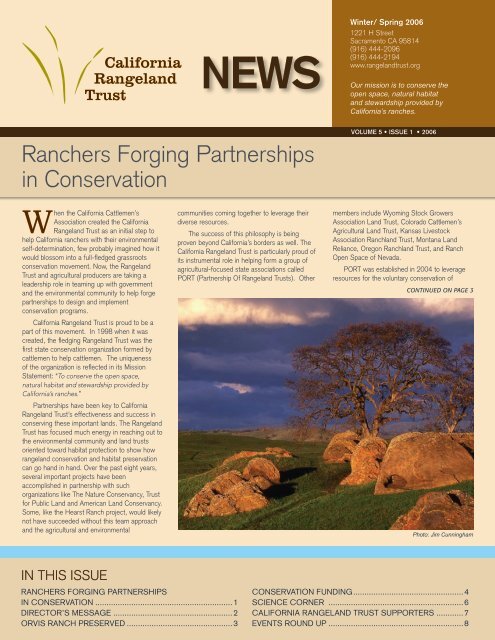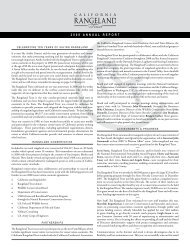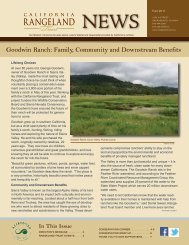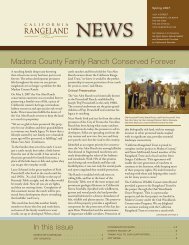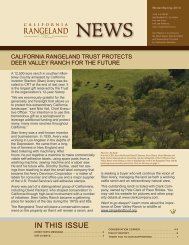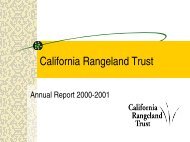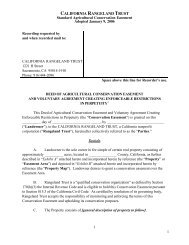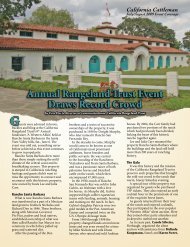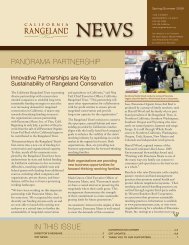CRT - Summer 2006 Newsletter - The California Rangeland Trust
CRT - Summer 2006 Newsletter - The California Rangeland Trust
CRT - Summer 2006 Newsletter - The California Rangeland Trust
Create successful ePaper yourself
Turn your PDF publications into a flip-book with our unique Google optimized e-Paper software.
NEWS<br />
Winter/ Spring <strong>2006</strong><br />
1221 H Street<br />
Sacramento CA 95814<br />
(916) 444-2096<br />
(916) 444-2194<br />
www.rangelandtrust.org<br />
Our mission is to conserve the<br />
open space, natural habitat<br />
and stewardship provided by<br />
<strong>California</strong>’s ranches.<br />
Ranchers Forging Partnerships<br />
in Conservation<br />
VOLUME 5 • ISSUE 1 • <strong>2006</strong><br />
When the <strong>California</strong> Cattlemen’s<br />
Association created the <strong>California</strong><br />
<strong>Rangeland</strong> <strong>Trust</strong> as an initial step to<br />
help <strong>California</strong> ranchers with their environmental<br />
self-determination, few probably imagined how it<br />
would blossom into a full-fledged grassroots<br />
conservation movement. Now, the <strong>Rangeland</strong><br />
<strong>Trust</strong> and agricultural producers are taking a<br />
leadership role in teaming up with government<br />
and the environmental community to help forge<br />
partnerships to design and implement<br />
conservation programs.<br />
<strong>California</strong> <strong>Rangeland</strong> <strong>Trust</strong> is proud to be a<br />
part of this movement. In 1998 when it was<br />
created, the fledging <strong>Rangeland</strong> <strong>Trust</strong> was the<br />
first state conservation organization formed by<br />
cattlemen to help cattlemen. <strong>The</strong> uniqueness<br />
of the organization is reflected in its Mission<br />
Statement: “To conserve the open space,<br />
natural habitat and stewardship provided by<br />
<strong>California</strong>’s ranches.”<br />
Partnerships have been key to <strong>California</strong><br />
<strong>Rangeland</strong> <strong>Trust</strong>’s effectiveness and success in<br />
conserving these important lands. <strong>The</strong> <strong>Rangeland</strong><br />
<strong>Trust</strong> has focused much energy in reaching out to<br />
the environmental community and land trusts<br />
oriented toward habitat protection to show how<br />
rangeland conservation and habitat preservation<br />
can go hand in hand. Over the past eight years,<br />
several important projects have been<br />
accomplished in partnership with such<br />
organizations like <strong>The</strong> Nature Conservancy, <strong>Trust</strong><br />
for Public Land and American Land Conservancy.<br />
Some, like the Hearst Ranch project, would likely<br />
not have succeeded without this team approach<br />
and the agricultural and environmental<br />
communities coming together to leverage their<br />
diverse resources.<br />
<strong>The</strong> success of this philosophy is being<br />
proven beyond <strong>California</strong>’s borders as well. <strong>The</strong><br />
<strong>California</strong> <strong>Rangeland</strong> <strong>Trust</strong> is particularly proud of<br />
its instrumental role in helping form a group of<br />
agricultural-focused state associations called<br />
PORT (Partnership Of <strong>Rangeland</strong> <strong>Trust</strong>s). Other<br />
members include Wyoming Stock Growers<br />
Association Land <strong>Trust</strong>, Colorado Cattlemen’s<br />
Agricultural Land <strong>Trust</strong>, Kansas Livestock<br />
Association Ranchland <strong>Trust</strong>, Montana Land<br />
Reliance, Oregon Ranchland <strong>Trust</strong>, and Ranch<br />
Open Space of Nevada.<br />
PORT was established in 2004 to leverage<br />
resources for the voluntary conservation of<br />
CONTINUED ON PAGE 3<br />
Photo: Jim Cunningham<br />
IN THIS ISSUE<br />
RANCHERS FORGING PARTNERSHIPS<br />
IN CONSERVATION .............................................................1<br />
DIRECTOR’S MESSAGE .....................................................2<br />
ORVIS RANCH PRESERVED ...............................................3<br />
Page 1<br />
CONSERVATION FUNDING .................................................4<br />
SCIENCE CORNER ............................................................6<br />
CALIFORNIA RANGELAND TRUST SUPPORTERS ............7<br />
EVENTS ROUND UP ............................................................8<br />
<strong>California</strong> <strong>Rangeland</strong> <strong>Trust</strong> . Winter/Spring <strong>2006</strong>
Director’s Message<br />
WHAT’S IN IT FOR ME?<br />
For me, the <strong>California</strong> <strong>Rangeland</strong> <strong>Trust</strong> didn’t start out to<br />
be such an immense undertaking. It began simply<br />
enough with an enabling resolution at the annual<br />
<strong>California</strong> Cattlemen’s Association meeting in December 1997.<br />
At the time, I knew virtually nothing about the laws and policies<br />
related to conservation easements, and had no inkling of the<br />
personal politics that affect the funding of our current efforts to<br />
conserve rangeland in <strong>California</strong>. When Matt Echeverria and<br />
Jerry Hemsted approached me about helping to start a land<br />
trust, I was unprepared for the amount of effort it would take to<br />
become conversant in the intricacies of land conservation and<br />
the establishment of a fully functioning board of directors. I<br />
was also unaware of my impending passion and commitment<br />
to what became the <strong>California</strong> <strong>Rangeland</strong> <strong>Trust</strong> and that this<br />
enthusiasm would be shared by so many smart, capable, and<br />
dedicated people.<br />
“Even the rich and famous disappear over time, unless<br />
they leave a charitable legacy.”<br />
Initially there were hours of conversation and consideration<br />
of how our “ranchers” land trust could best help <strong>California</strong><br />
cattlemen. We talked about creating directories of rancher<br />
friendly experts to help with governmental regulations. We<br />
wanted to be a full service rancher support organization. When<br />
our doors opened in the middle of 1998, I think the newly<br />
appointed board was universally unprepared for the stampede<br />
of ranchers who had been waiting to establish conservation<br />
easements on their lands. Our customers caused an<br />
immediate refocusing of our efforts. Today we have completed<br />
some great easements on beautiful ranches around the state,<br />
constituting over 176,000 acres of conservation, and we are<br />
further behind than we were seven and a half years ago.<br />
<strong>The</strong>re are over 49 ranching families on our waiting list, whose<br />
past stewardship has preserved nearly a half million acres of<br />
valleys, mountains, river lands, oak woodlands and meadows.<br />
<strong>The</strong>re are, of course, other land trusts operating in<br />
<strong>California</strong>. <strong>The</strong> difference is that our first responsibility is to the<br />
continuation of land stewardship through ranching. We know<br />
that most endangered species rely on our ranches and don’t<br />
understand why any organization thinks a well run ranch should<br />
have new management. We don’t work on an easement<br />
unless it is for a ranching family that appreciates and protects<br />
all those other values that we associate with rangeland, but<br />
once we agree that a place has been well cared for, our<br />
easements simply seek to maintain that care forever.<br />
I have to admit that the thousands of hours that I have<br />
spent in meetings, helping develop policies to protect <strong>California</strong><br />
<strong>Rangeland</strong> <strong>Trust</strong> and our rancher partners, working on<br />
easements, and agonizing over where we will get the money to<br />
save this beautiful state, have taken its toll. Sometimes I<br />
simply can’t face another email, phone call, or drive to<br />
Sacramento. <strong>The</strong>n I look around and see the bulldozers busily<br />
converting our range into terraced tracts of urbanity, and a<br />
renewed sense of urgency grips me. So many ranches, so<br />
little time.<br />
So, what’s in it for me? Other than raising good kids, there<br />
aren’t that many things that a person can do that make a<br />
difference beyond our lifetime. Even the rich and famous<br />
disappear over time, unless they leave a charitable legacy.<br />
<strong>The</strong> great businessmen of a century ago pioneered great<br />
companies that are mostly gone now, but working with the<br />
<strong>Rangeland</strong> <strong>Trust</strong> gives me, my incredibly dedicated codirectors,<br />
and our supporters the opportunity to make a<br />
permanent difference. <strong>The</strong> landscapes that we can help<br />
ranchers protect ensure that future generations will experience<br />
what our pioneer ancestors<br />
witnessed. <strong>The</strong> wildlife and<br />
woodlands will endure because we<br />
joined with conscientious and caring<br />
ranchers to preserve a place and<br />
lifestyle that provides for more than<br />
the owner. We may be forgotten, but<br />
what we accomplish will never be.<br />
~Steve Sinton<br />
Page 2<br />
<strong>California</strong> <strong>Rangeland</strong> <strong>Trust</strong> . Winter/Spring <strong>2006</strong>
Ranchers Forging Partnerships<br />
in Conservation<br />
PARTNERSHIPS, CONTINUED FROM PAGE 1<br />
America’s rangelands and to increase the<br />
input of agricultural producers into land<br />
conservation issues.<br />
During the fall of 2005, the combined<br />
total acreage conserved by the seven<br />
members of PORT through conservation<br />
easements surpassed the one million<br />
mark (1,062,000 acres). Comparatively,<br />
one out of every seven acres safeguarded<br />
through conservation easements in the<br />
United States was accomplished by a<br />
PORT member, making participant<br />
organizations among the most successful<br />
and fastest growing land trusts in the<br />
country. This success is attributed to<br />
PORT members’ unique grassroots<br />
structure of being formed by agricultural<br />
producers for agricultural producers.<br />
Now, as <strong>California</strong> <strong>Rangeland</strong> <strong>Trust</strong><br />
approaches the end of its eighth year,<br />
much pride and some disbelief are<br />
experienced as over 176,000 acres are<br />
under conservation easements and active<br />
projects in process represent 374,747<br />
additional acres.<br />
<strong>California</strong> <strong>Rangeland</strong> <strong>Trust</strong>’s directors<br />
and staff have been most gratified by<br />
the enthusiastic reception and support<br />
the <strong>Rangeland</strong> <strong>Trust</strong> has received from<br />
both the ranching and conservation<br />
communities. Moving forward together<br />
will preserve <strong>California</strong>’s golden working<br />
landscapes and the habitats they provide<br />
while keeping the ranching tradition a<br />
cornerstone of <strong>California</strong>’s economy<br />
and heritage.<br />
Tim Koopmann, <strong>California</strong> <strong>Rangeland</strong> <strong>Trust</strong> Director<br />
explains the importance of working together:<br />
“Our member ranchers, the folks who have the land where the species thrive,<br />
invited participation and support from segments of <strong>California</strong> beyond the<br />
agricultural community, including enlightened environmentalists and<br />
government agency representatives who understand that well managed<br />
grazing is one of the best ways to protect the environment. <strong>The</strong>y soon came<br />
to realize that animal and plant species thrive on grazed rangeland better than<br />
unmanaged land: When you preserve ranches you preserve nature.”<br />
Photo: Jim Cunningham<br />
Historic 2563-Acre Orvis Ranch in Calaveras County Preserved<br />
<strong>The</strong> historic Orvis Ranch will forever continue as a working cattle ranch under a conservation contract between the Orvis family and <strong>California</strong><br />
<strong>Rangeland</strong> <strong>Trust</strong>. <strong>The</strong> agreement was finalized and recorded March 31, <strong>2006</strong>.<br />
Established in 1873 by the Orvis family and still owned and operated by fourthgeneration<br />
members of the family, Bruce and Roma Orvis, the ranch in Calaveras<br />
and Stanislaus counties possesses exemplary grazing, habitat and scenic open space<br />
values. <strong>The</strong> ranch also rests in a precarious position along Highway 4 in the Sierra<br />
Foothills with residential and rural ranchette development closing in rapidly from the<br />
north, east and west.<br />
“Four generations put it together, and there’s no way I wanted to be responsible for<br />
the ranch being cut up,” says Bruce Orvis. “It’s a dream of mine that this place stays<br />
big open country.”<br />
Bruce and Roma run a cow-calf operation and breed award-winning Hereford bulls.<br />
Project funding was obtained by the <strong>Trust</strong> for Public Land in partnership with the<br />
<strong>California</strong> <strong>Rangeland</strong> <strong>Trust</strong> through the <strong>California</strong> Farmland Conservancy Program, the<br />
USDA Farm and Ranchland Protection Program and the Great Valley Center.<br />
Photo: Bill Orvis<br />
www.rangelandtrust.org<br />
Page 3
Conservation Funding<br />
FUNDING EASEMENTS IN A CHALLENGING ECONOMY<br />
When I joined <strong>California</strong> <strong>Rangeland</strong> <strong>Trust</strong> as Transaction<br />
Director in February of 2004, there were seven projects<br />
waiting to be closed. Five of those projects had funding from<br />
the <strong>California</strong> Wildlife Conservation Board. <strong>The</strong> other two<br />
were mitigation projects with funding provided by the entity<br />
needing to mitigate for development elsewhere. <strong>The</strong> ranches<br />
were located in the counties of Alameda, Merced, Placer,<br />
Plumas, San Luis Obispo, Sierra and Yolo. It took over a year<br />
to close the seven projects and when they were done,<br />
<strong>Rangeland</strong> <strong>Trust</strong>’s portfolio of conserved acreage had<br />
increased to nearly 173,000 acres.<br />
ranches, we have been exploring new funding sources.<br />
Working with <strong>Trust</strong> for Public Land, funds were secured for a<br />
Central Valley ranch from the U.S. Department of Agriculture<br />
(USDA)-Natural Resources Conservation Service (NRCS)<br />
Farm and Ranchland Protection Program and the <strong>California</strong><br />
Department of Conservation Farmland Conservancy Program<br />
(see Orvis Ranch project in this newsletter). <strong>The</strong> Great<br />
Valley Center also provided grant funds for that project. We<br />
are hopeful this combination of federal and state funds may<br />
work for other <strong>California</strong> <strong>Rangeland</strong> <strong>Trust</strong> projects that meet<br />
the specific requirements of the two programs.<br />
Funded easements<br />
Most of the Wildlife Conservation Board funds used for the<br />
five projects were the result of Propositions 40 and 50<br />
approved by the voters of <strong>California</strong> in 2002. Proposition 40<br />
earmarked $75 million to <strong>California</strong> <strong>Rangeland</strong>, Grazing Land<br />
and Grasslands, a program specifically designed to conserve<br />
working ranches in <strong>California</strong>. Two of the seven projects<br />
mentioned above were funded through that grazing program.<br />
<strong>Rangeland</strong> <strong>Trust</strong> has one additional project, the El Chorro<br />
Ranch (see Fall, 2005 <strong>Newsletter</strong>) recently completed with<br />
funds from this program.<br />
A few of the projects that closed in 2005 also received funds<br />
from private foundations to pay for acquisition costs as well as<br />
monitoring and transaction costs. <strong>The</strong>se private funds were<br />
crucial to the success of the projects because Wildlife<br />
Conservation Board funds can only pay for acquisition of the<br />
easement and not for any transaction costs or monitoring.<br />
With 172 land trusts in <strong>California</strong>, the demand far exceeded<br />
the amount of bond funds allocated for conservation<br />
easements from Propositions 40 and 50. Money from private<br />
foundations has also dwindled in the last two years for a<br />
variety of reasons including the decline in the stock market.<br />
While the amount of funds available to fund projects is<br />
diminishing, the interest in conserving rangeland is increasing.<br />
<strong>California</strong> <strong>Rangeland</strong> <strong>Trust</strong> currently has 49 project<br />
applications representing nearly an additional 400,000 acres.<br />
In order to facilitate the conservation easement on these<br />
Donated easements<br />
<strong>California</strong> <strong>Rangeland</strong> <strong>Trust</strong> has been in discussions with a few<br />
ranchers who are willing and able to donate a conservation<br />
easement. <strong>The</strong> donation of a conservation easement is a<br />
charitable contribution for federal and state tax purposes, and<br />
should be considered by any owner who can utilize the tax<br />
benefits. Even a partial donation of the value of the easement<br />
can provide tax benefits.<br />
<strong>The</strong> future of funding<br />
<strong>The</strong> prospect for substantial new bond funds earmarked for<br />
agricultural conservation is unlikely. A bond measure is<br />
expected to appear on the November <strong>2006</strong> ballot. It is not<br />
expected that this bond will provide the needed funds for<br />
agricultural conservation easements. An initiative bond<br />
measure is also currently garnering signatures to qualify<br />
for the Fall ballot. That proposal, unfortunately, only<br />
proposes a paltry sum for all agricultural conservation<br />
easements in <strong>California</strong>.<br />
In order to estimate a meaningful amount needed from any<br />
future bond measures to fund the list of applications<br />
<strong>Rangeland</strong> <strong>Trust</strong> has accepted, I looked at the range of per<br />
acre easement prices for the projects closed in 2005<br />
(excluding Hearst Ranch which is an anomaly due to its<br />
enormous size) that were funded through Propositions 40<br />
and 50. <strong>The</strong> 2003-2004 appraised per acre conservation<br />
easement value ranged from $209 to $730. Using this<br />
Page 4<br />
<strong>California</strong> <strong>Rangeland</strong> <strong>Trust</strong> . Winter/Spring <strong>2006</strong>
Conservation Funding<br />
range, the amount needed for acquisition only of conservation<br />
easements for the existing 49 applications is between $83<br />
Million to $292 Million. Obviously, that range is low with the<br />
escalation of real estate values throughout <strong>California</strong>, and will<br />
not provide the additional funds needed for monitoring and<br />
transaction costs.<br />
<strong>California</strong> <strong>Rangeland</strong> <strong>Trust</strong> is participating in discussions on<br />
the bond measures urging legislators to include a significant<br />
amount of funds for the acquisition of agricultural conservation<br />
easements, but we need your help. Contact your local state<br />
senator and assemblyman and express your support of<br />
agricultural conservation<br />
easements. Tell them<br />
about the benefits of<br />
privately owned<br />
rangeland and why it is<br />
important to include a<br />
significant amount of<br />
funds in the bond<br />
measures for agricultural<br />
conservation easements.<br />
(See inset box.) A<br />
grassroots appeal may<br />
help the legislators realize<br />
the long-term benefits to<br />
<strong>California</strong> of acquiring<br />
agricultural conservation<br />
easements.<br />
~Michele Clark<br />
BENEFITS TO CALIFORNIA<br />
FROM CONSERVATION EASEMENTS<br />
• Land remains on tax rolls and landowner<br />
continues paying property taxes.<br />
• Less expensive for <strong>California</strong> to acquire<br />
development rights through a conservation<br />
easement than to own fee title and pay<br />
on-going maintenance and management<br />
• Maintains Western heritage of <strong>California</strong><br />
• Keeps agricultural base within local community<br />
• Helps family ranchers continue their livelihood<br />
and helps maintain the long-term viability of<br />
their agricultural businesses<br />
ESTATE PLANNING<br />
As many of you consider your estate planning options, please be sure to remember <strong>California</strong> <strong>Rangeland</strong> <strong>Trust</strong> as a<br />
beneficiary. Your financial planning efforts can contribute greatly to conserving rangeland in <strong>California</strong> and providing a<br />
historical legacy to the ranching families of tomorrow. When discussing options with your tax advisor, attorney or<br />
financial planner, <strong>California</strong> <strong>Rangeland</strong> <strong>Trust</strong> remains a resource to assist you and your family in finding a way that you<br />
personally can contribute to the efforts of “conserving the open space, natural habitat and stewardship provided by<br />
<strong>California</strong>’s ranches”.<br />
www.rangelandtrust.org<br />
Page 5
Science Corner<br />
Pools in the Grass<br />
Amid the Central Valley’s vast sea of now<br />
exotic grasses lie some of the oddest ecological<br />
islands in <strong>California</strong>. Known as vernal pools,<br />
they are home to dozens of tiny plants and<br />
animal species that live nowhere else in the<br />
world. From microscopic fairy shrimp to dainty<br />
white popcorn flowers, each has adapted to a<br />
world that floods in winter and dries to a crisp<br />
by summer. Vernal pools owe their existence to<br />
a confluence of geology and climate. When<br />
winter and spring rains fall on hardpan and<br />
claypan soils, the resulting pools may linger for<br />
many weeks or months. <strong>The</strong> sudden arrival of<br />
moisture rouses the pools’ dormant residents to<br />
life. During the heady few months while the<br />
ponds are wet, a frenzy of hatching, courting,<br />
and mating goes on. After all, there isn’t much<br />
time. Clouds can disappear and pools evaporate<br />
with no whisper of warning.<br />
So the first chance they get, spadefoot<br />
toads dig their way upward from several feet<br />
beneath the soil and set out to catch their meal<br />
of the year. After nightfall, tiger salamanders<br />
waddle out of borrowed ground squirrel burrows<br />
and look for mates beneath the stars. Just add<br />
water to the cysts of tadpole and fairy shrimp—<br />
really embryos in suspended animation—and<br />
they’ll hatch into instant adults. <strong>The</strong>ir wiggling<br />
legs and waving antennae offer a welcome<br />
Photo: Jim Cunningham<br />
snack for waterfowl migrating along the Pacific<br />
Flyway. As the waters recede, the animals<br />
vanish too, hunkering down into the soil for<br />
another year. Now the wildflowers emerge,<br />
surrounding each pool in rainbow rings. Yellow<br />
tidy-tips, their toothy petals edged in white, may<br />
grow in concentric circles along with violetbearded<br />
downingia, lilac-tinted meadowfoam,<br />
and carpets of miniature goldfields. Each week<br />
of drying brings one or two new blooms as<br />
another species sets seed and fades.<br />
Each pool—and there may be dozens in a<br />
single field—shelters a unique community of<br />
animals and plants. Across <strong>California</strong>,<br />
naturalists have identified more than 100<br />
species that live only in and around vernal<br />
pools. “<strong>The</strong>ir disappearance or decline would<br />
mean a significant loss of state biodiversity,”<br />
says Jaymee Marty, an ecologist with <strong>The</strong><br />
Nature Conservancy. By the early 1970s,<br />
<strong>California</strong> had already lost approximately 80%<br />
of its pools. Fast-growing Sacramento County<br />
alone has lost more than 30% of its pools over<br />
the last decade.<br />
Biologists are studying how best to preserve<br />
the few pools that remain. Most occur in areas<br />
that have been rangeland for the past 100<br />
years. To determine whether cattle grazing is<br />
good or bad for vernal pool health, Marty<br />
studied 72 pools on 12,362 acres of the<br />
Howard Ranch in eastern Sacramento County<br />
(a non-CALFEDfunded study). She allowed<br />
cows and calves to graze on some pools, but<br />
excluded the livestock from others. She also<br />
surveyed the species diversity at each pool<br />
annually during the three-year experiment.<br />
“We suspected we wouldn’t find a perfect<br />
fit, that for some species grazing would be<br />
positive and for others, negative,” Marty says.<br />
“But in the end, we found the historic level of<br />
grazing actually had the highest diversity for<br />
both native plants and aquatic invertebrates.”<br />
Without grazing, native plant cover dropped by<br />
20% to 50% at both pool edges and upland<br />
areas, while exotic grasses increased their<br />
territory. Wildflowers and other forbs declined,<br />
while grasses began to dominate.<br />
In addition, protected pools dried an<br />
average of two months faster than grazed<br />
pools. <strong>The</strong> extra time can spell the difference<br />
between life and death for species like the<br />
<strong>California</strong> tiger salamander. “<strong>The</strong>y need 90 days<br />
for larvae to turn into adults and walk out of the<br />
pools,” says Marty. If the pools dry up too fast,<br />
salamanders “are going to be stranded and die.”<br />
She suspects much of the water in the<br />
ungrazed pools was sucked out of the pool by<br />
the extra grass.<br />
Non-native grasses pose another threat to<br />
this fragile habitat. Most invasive species can’t<br />
withstand the dramatic moisture swings and<br />
alkaline soil found within the pools.<br />
Unfortunately, those defenses don’t faze all<br />
non-natives. Pepperweed, for example,<br />
marches right in on spreading subterranean<br />
runners. Growing up to three feet tall, it starves<br />
petite natives of nutrients, moisture, and<br />
sunlight.<br />
Biologist Niall McCarten of Environmental<br />
Science Associates managed a CALFED<br />
study to determine how to eliminate<br />
pepperweed from a 320-acre vernal pool site at<br />
the former McClellan Air Force Base. He faced<br />
a terrible dilemma. Pulling up the plants and<br />
their runners by hand would disturb the soil, and<br />
could upset the ecology of the pool. And while<br />
herbicide spraying would kill the weed, it might<br />
also contaminate pool water and kill native<br />
wildflowers, including endangered species. He<br />
opted for a more painstaking approach instead.<br />
After the pools dried, his scientists trimmed the<br />
tops from many pepperweed plants with hand<br />
shears. <strong>The</strong>y handpainted some with the<br />
herbicide Roundup, and left the other clipped<br />
weeds alone.<br />
A month later, the weeds that had been<br />
clipped and painted were dead, and some<br />
species of endangered grasses in those plots<br />
increased in size and number. Meanwhile, those<br />
that had only been clipped were regenerating.<br />
Control plots, where pepperweed had been left<br />
unmolested, had done even worse, losing an<br />
average of four individual endangered grass<br />
plants per experimental plot. <strong>The</strong> group plans to<br />
return this summer to see how the plots have<br />
fared a year later.<br />
“It is labor intensive, but the results are<br />
worth it,” McCarten says. After all, the pools are<br />
also the only known habitat for Solano grass, a<br />
federally endangered species. “When you’ve<br />
got such rare species, we’d rather not take<br />
big risks.”<br />
Reprinted from June 2005 issue of SCIENCE ACTION, with permission<br />
from CALFED Bay-Delta Science Program, Author Kathleen M. Wong<br />
Page 6<br />
<strong>California</strong> <strong>Rangeland</strong> <strong>Trust</strong> . Winter/Spring <strong>2006</strong>
Thank you to our Supporters<br />
Donations from October 2005 through April <strong>2006</strong><br />
A.B. Land Development<br />
A. L. Gilbert and Company<br />
Leo Acquistapace<br />
Agriculture Industries<br />
David Anderson<br />
Stephanie Reynolds Anderson<br />
Ronald and Bonnie Ann Andre<br />
Bar Seven Custom Ranching<br />
Wayne and Patsy Barber<br />
Betty Barnes<br />
David and Cheryl Beal<br />
J. H. Bechtel<br />
Jonathan and Dianne Becker<br />
Berry and Berry Law Office<br />
Constance Berto<br />
Richard and Laura Bess<br />
Morgan Blasingame<br />
Robert and Kathrine Bowen<br />
Michael Patrick Brandon<br />
T. Scott and Charlotte Brooke<br />
Joan Bushman<br />
Byrd Cattle Co L.L.C.<br />
Capital Meeting Planning<br />
A.C. Carrion<br />
Jon Cartwright<br />
Anne M. Carty<br />
Dennis Cassidy<br />
Melinda and Wayne Cecchettini<br />
Ceci Dale-Cesmat<br />
Jeff and Ginger Chance<br />
Ken Christen<br />
Peter G. Clark<br />
Colburn Cattle<br />
Coles Cattle Company<br />
Community Foundation of Santa Cruz County<br />
Jack and Shannon Collison<br />
Diane P. Cooley<br />
Crawford Multari and Clark Associates<br />
Cowell Ranch<br />
Jim Cunningham<br />
Davis Creek Land and Cattle<br />
Rick and Kerry De Benedetti<br />
Dorrance Ranches<br />
Bob and Helene Dorris<br />
Double S Bar Land and Cattle Company<br />
V.C. Dwight<br />
Edwards and Lien, Inc.<br />
El Sur Ranch<br />
Stuart Epstein<br />
Peter Fallini<br />
A.J. and Sue Benech Field<br />
Gary and Darlene Felsman<br />
Jan Feuerbach<br />
Michael and Jeanette Fitch<br />
Five Dot Land and Cattle<br />
Fort Dodge Animal Health<br />
David and Patria Forster<br />
Thomas Freitas Jr.<br />
Fresno-Kings Cattlemans Association<br />
Fresno Meat Company<br />
<strong>The</strong> Bob and Marie Gallo Foundation<br />
Donja Garvey<br />
Jim Gaskin<br />
Pam and Henry Giacomini<br />
Bruce Gibson and Grace Crittenden<br />
Anthony and Laurel Gilbert<br />
Allen and Tracy Gill<br />
Will Gill and Sons<br />
George Goodwin Family LP<br />
Erik and Sandy Gregersen<br />
J. Less Guthrie<br />
Steve Hackett<br />
Wendy and Michael Hall<br />
Dave Hamel<br />
Susan and John Hand<br />
Coburn Haskell<br />
George R. Hearst Jr<br />
Bill and Donna Hendrix<br />
Ronald Hilder, D.D.S.<br />
Dale W. Hillman<br />
Hollister Ranch Cooperative<br />
Fredrick and Susan Hunt<br />
Lavonne Hughes<br />
Isaacson Family<br />
Travis and Jennifer Jackson<br />
Bert and Gretchen Johnson<br />
Anthony V. Keese<br />
Dennis R. Keller<br />
Kevin and June Kester<br />
Steven Kirby<br />
Sheilah Kreyenhagen<br />
Kuck Hereford Ranch<br />
Joy Law<br />
Lacey Livestock<br />
Frank Long<br />
Lonestar Ranch<br />
Dr. John Lunt<br />
Louise Davies Foundation<br />
Low’s Furniture Company Inc.<br />
Lyon Realstate<br />
Maddalena Ranch<br />
John and Kathy Maino<br />
Patty A. McCrory<br />
Daniel G. McQueeney<br />
James Merrill<br />
Earl and Gina Merritt<br />
Andrew Mills<br />
Kyoko T. Mitsuoka<br />
Moiso Living <strong>Trust</strong><br />
Patrick Molnar<br />
Monsanto<br />
Jean Montgomery<br />
Gary Montgomery<br />
Moran Ranch<br />
Moore Biological Consultants<br />
Multiple Use Managers<br />
Maurice Nasrah<br />
National Fish and Wildlife Foundation<br />
In Memoriam<br />
In Memory of Jack E. Russell<br />
R.H. Chamberlain<br />
Anne and Colin Lind Family<br />
Victoria L Davis<br />
Drs. Ellen Mahoney<br />
John Hagan<br />
and Luther Cobb<br />
J. Timothy Lane<br />
Mission Produce<br />
Marie Mahoney Myers<br />
Chip and Shirin Coelman<br />
Patricia and Hayes Noel<br />
Norene Ranches, Inc.<br />
Robert O’dell<br />
Bruce and Roma Orvis<br />
Roy and Roberta Parsons<br />
Payne Family Partnership<br />
Pelco<br />
Pitto Ranches Inc.<br />
Alexandra Power<br />
Heloise Power<br />
Rancho Canada Larga<br />
Rancho Delux Design<br />
Rancho Paloma<br />
Rancho San Simeon<br />
Blake and Jill Rassmussen<br />
William and Valerie Raymond<br />
Gary Reed<br />
John and Peggy Rice<br />
Roy and Dana Richards<br />
Richard and Nancy Richardson<br />
Richard and Evelyne Rominger<br />
Craig Rust<br />
Manfred and Jean Sander<br />
W. Ralph Schaefer<br />
Frances Scovel<br />
Bill and Paige Shaw<br />
Sierra Valley Ranch<br />
Jim and Norma Sinton<br />
Slykerman AG Aviation, Inc<br />
Cora Sparrowk<br />
Scott and Annette Spear<br />
RIchard and Judy Standiford<br />
Roger Sternberg<br />
John and Elisabeth Stevenson<br />
Dave Stix Livestock<br />
Table Rock Ranch<br />
Tulloch Family Partners, LLP<br />
Sunshine Turkey Farms<br />
Robert L. Thomas<br />
William Thomas, Jr<br />
Robert J. Thompson<br />
United Way of San Louis Obispo County, Inc.<br />
Vaquero Cattle Company<br />
Richard Volberg<br />
John and Deborah Weatherford<br />
Western Stockmans Market<br />
Mark Wheeler<br />
Donald Rex Whittle<br />
Jeff and Nancy Wiedemann<br />
Wildlands, Inc.<br />
Brian Wolf<br />
Work Family Estate <strong>Trust</strong><br />
Darrell Wood<br />
Leland and Marlene Wood Jr.<br />
Cal Worthington<br />
Yolo Land and Cattle<br />
www.Patagonia.com<br />
In Honor of Kathy Carlson<br />
In Memory of Duncan C McCormack Jr<br />
Harvey L. and Maud C. Sorensen Foundation<br />
In Memory of Jim Ryan<br />
Darrel and Karen Sweet<br />
In Memory of John S. Kiewit<br />
Ralph and Oralee Kiewit<br />
CALIFORNIA<br />
RANGELAND<br />
TRUST<br />
BOARD OF DIRECTORS<br />
Darrell Wood, Chairman<br />
Vina<br />
Devere Dressler, Vice Chair<br />
Gardnerville<br />
Scott Stone, Secretary<br />
Woodland<br />
Steve McDonald, Treasurer<br />
Sanger<br />
Woody Barnes<br />
Julian<br />
Mike Bennett<br />
Ducor<br />
Brandy Branquinho<br />
Los Alamos<br />
Holly Foster<br />
Oroville<br />
Tim Koopmann<br />
Sunol<br />
Jennifer Rice<br />
Clements<br />
Steve Sinton<br />
Shandon<br />
Darrel Sweet<br />
Livermore<br />
Kendra Wilber<br />
Clements<br />
Nita Vail<br />
Executive Director<br />
Michele Clark<br />
Transaction Director<br />
Andy Mills<br />
Stewardship Director<br />
Jon Cartwright<br />
Finance Manager<br />
Jennifer Caputo<br />
Executive Assistant<br />
Heather Newman<br />
<strong>Newsletter</strong> Editor<br />
Contributing to this issue:<br />
Steve Sinton, Holly Foster,<br />
Jim Cunningham, Nita Vail, Michele<br />
Clark, Andy Mills, Jon Cartwright,<br />
Jennifer Caputo and Heather Newman.<br />
www.rangelandtrust.org<br />
Page 7
Events Round Up<br />
Nominations Open for<br />
Leopold Conservation Award<br />
<strong>The</strong> Sand County Foundation is seeking nominations for <strong>The</strong> Leopold<br />
Conservation Award for properties in <strong>California</strong> that exhibit innovative<br />
leadership and innovation in conservation.<br />
<strong>The</strong> Leopold Conservation Award Panel will be evaluating properties in<br />
three broad categories: Nurseries and Crops; Dairy, Beef and Poultry;<br />
and, <strong>Rangeland</strong> and Timber. <strong>The</strong> review panel will use criteria based on<br />
responsible and sustainable land management, economics, innovation,<br />
overall land health, and community outreach and leadership.<br />
<strong>The</strong> award program is a partnership between the Foundation and the<br />
<strong>California</strong> Farm Bureau Federation and Sustainable Conservation. <strong>The</strong><br />
Leopold Conservation Award winner receives a crystal rendering of Aldo<br />
Leopold and a check for $10,000.<br />
For more information and a nomination form, go to the Foundation’s<br />
web site at www.sandcountry.net.<br />
Fifth Annual “A Western Affair”<br />
<strong>California</strong> <strong>Rangeland</strong> <strong>Trust</strong>’s<br />
Annual Benefit<br />
This year’s signature event will be held at John and Carole Harris’s,<br />
Fifth Annual “A Western Affair”, June 3, <strong>2006</strong>. Join us for a special<br />
evening at this beautiful venue on the Kings River near Sanger.<br />
Our supporters know what fun it is to enjoy an evening of superb food<br />
and great company while contributing to conserving our Western legacy<br />
and <strong>California</strong>’s rangelands. Through work of the <strong>California</strong> <strong>Rangeland</strong><br />
<strong>Trust</strong>, more than176,000 acres of rangeland, open space and habitat<br />
have been protected, creating a stable business environment for the<br />
state’s ranchers and a healthy future for <strong>California</strong>ns.<br />
Be a part of this <strong>California</strong> tradition of conservation, stewardship, and<br />
charitable giving. <strong>The</strong>re are still tickets left, so call Jennifer in the <strong>CRT</strong><br />
office at (916) 444-2096 or go to www.rangelandtrust.org if you would<br />
like to join us for a memorable and fun evening.<br />
Non-Profit Org.<br />
U.S. Postage<br />
Paid<br />
Permit No. 2180<br />
Sacramento CA<br />
1221 H Street • Sacramento, CA 95814<br />
www.rangelandtrust.org


